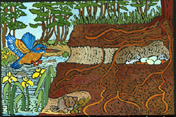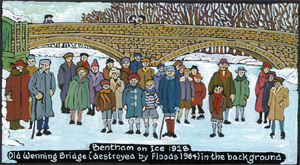Where
does the Wenning come from? Clapham Beck, which gathers the rain
off Ingleborough's vast flanks, disappears down Gaping Gill and
re-emerges from Ingleborough Cave. It then wends south to
Clapham Station, where it's joined by Austwick Beck and Fen Beck,
with Kettlesbeck and Keasden Beck. These mixed waters now become
the Wenning and eventually join the Lune below Hornby, and so
it flows on into the Irish Sea, where the rain cycle begins once
again.
|

"The Vale ofWenning I resolved
to tread / And trace the radiant rambler to its head".
These are the opening lines of a charming poem describing the
whole course of the
river, written by Thomas Dixon in 1781, and recently reprinted.
By turns radiant or raging, this river has also inspired artists,
such as J.M.W. Turner, who painted it in about 1820.
|
|
 A hidden
world inside the riverbank. A hidden
world inside the riverbank.
Trees play a vital part in the anatomy
of a river. Roots hold the Riverbank together and give homes
to all kinds of burrowing animal, including the kingfisher. Fallen
leaves enrich the water with many nutrients. Just as important
are rocks, large and small, stirring and tumbling life-giving
oxygen into the stream. As a "rocky river with plenty of
trees" the Wenning is an exceptionally lively wild river
and well repays close observation. It is ecology in motion. As
it draws its waters from such a vast area, in times of heavy
rain it floods quickly and violently, often sweeping away trees
or bridges - this new "Shaky" bridge is the latest
of many. Then the river turns from raging back to radiant, perfect
for paddling, picknicking,
and pebble-hunting. People are part of its ecology too. It
is of economic value too: for centuries its energy has powered
local industries (including, nowadays, a trout farm) ; its waters
turned wheels or became steam in mill-boilers and railway engines.
In the social life of Bentham it has always played a huge part,
providing year-round fun for free.
|
Though often frothy with peat from its moorland tributaries,
the Wenning is unpolluted and supports lots of wildlife.
Least obvious but most vital are the tiny insects, larvae &
crustaceans who live on the stream bottom, feeding on scraps
of leaf ("detr itus"). These are the f ood of bigger
fish, which are caught and eaten by birds, voles, otters, and
anglers

(broadband users can click on this
picture)
The principal natural fish is the Brown Trout. It lives here
all year round. From July onwards, Sea Trout and Salmon - migratory
fish - navigate up the Lune and the Wenning. Somewhere between
High Bentham and Austwick - the exact location varies from year
to year depending on weather and riverbed conditions - they will
spawn, between November and January, and then either die of exhaustion
or return to the sea to recharge their energies and return to
breed again the following year.
 Until it was all swept away by the great
flood of 1964, a weir below the Wenning Bridge created a huge
swimming pool, 100 yards long & 9 feet deep. Swimming Galas
were held (a hut provided changing rooms) and the huge gravel
beach was the town's meeting place and playground all summer
long. In winter the pool would often freeze over, making an immense
ice-skating rink. Night-fishing for sea-trout remains a popular
pastime to this day.
Until it was all swept away by the great
flood of 1964, a weir below the Wenning Bridge created a huge
swimming pool, 100 yards long & 9 feet deep. Swimming Galas
were held (a hut provided changing rooms) and the huge gravel
beach was the town's meeting place and playground all summer
long. In winter the pool would often freeze over, making an immense
ice-skating rink. Night-fishing for sea-trout remains a popular
pastime to this day. |
|